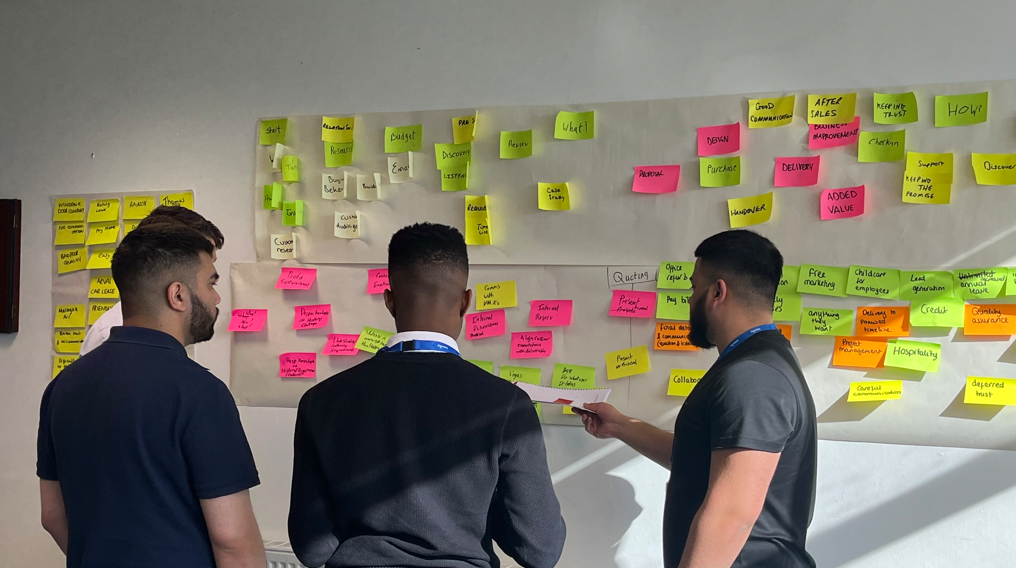Coach versus Mentor: the developing battle
Thanks to the team at The Speaking Business magazine for publishing Nevil’s article on developing coaching skills.
Lots of people offer coaching and my guess is that you will have experienced coaching in some form or another as part of your business career. I have been coached, coached others and trained a huge number of managers, directors and business owners in coaching techniques (my start in coaching was building a team of 12 sales coaches for a business wanting to hit a £963-million-pound target).
It might be worth clarifying what coaching means to me, as you may have come across numerous development techniques, each under the coaching banner. (To clarify, I am talking about coaching for business here, don’t even get me started on sport!). When I talk about coaching, I specifically mean non-directive coaching: it’s coaching that focuses on questioning your coachee (the person you are coaching) and ultimately supporting them so that they realise their own ideas and solutions. This creates a clear distinction between what I call coaching and mentoring. For clarity, a mentor is a trusted, experienced individual or teacher and mentoring is the process of sharing experience and lessons learned with a mentee (the person you are mentoring). The term mentor describes a relationship where a more experienced person shares knowledge, skills, experience, career, information, technical approach, ideas etc. to create a bigger picture for their mentees.
Comparing these two approaches, the core distinction to draw is that a mentor tells their mentee, while a coach asks their coachee.
Thinking back to what you have experienced in the past: was it more tell or was it more ask? While plenty of one-to-one time gets badged as coaching, under closer examination, there’s a high incidence of telling going on (rather than asking). And the reasons? Because it’s easier to tell; asking makes them feel a little uncomfortable.
Why ask?
Some wonderful things happen when we learn to ask and resist the temptation to tell:
- Your coachee is fully engaged in the conversation (rather than the conversation being done to them), which means they are thinking.
- Coachees are involved in creating their own solutions and ideas, shifting their perspective as they see the world anew.
- The coachee buys into the solution, which means that ownership of actions increases.
- As the coach, you are engaging the coachee’s internal voice.
It’s this last point that is at the heart of non-directive coaching. Telling someone to do something has a time and a place, for example, when someone lacks the skills, knowledge and experience needed to reach a solution quickly. However, in the wrong situation, telling can be quite damaging.
Think about you doing your job: speaking, training or running workshops. If you are highly experienced in doing these things, and someone turns up and tells you how to do one of these things in (what they claim to be) a better way, how do you feel about their ideas?
Now imagine if, instead, they asked you some simple questions that caused you to reflect on your last speaking gig or workshop, and in doing so they helped you spot some development areas. You are more likely to buy into this approach because you’re listening to your own ideas.
Developing your coaching approach: beware the pitfalls
Coaching. Done at the right time, in the right way is powerful. Here’s a not-so-secret list of seven pitfalls to avoid, so that your coaching hits the spot more of the time:
- Not every situation is a coaching opportunity, sometimes tell is more appropriate
- Coaching and asking is much harder than telling; you need to resist the temptation to slip back to a default tell. You won’t be the first person: a senior manager once told me that coaching was all soft and fluffy; after the first day of training he admitted that not telling, but pausing to ask was one of the most difficult things he had learned to do
- Great coaches do lots of preparation work to ensure they can ask great questions…but they don’t script the coaching session
- Great questions are a waste of time until you know how to listen
- Listening will be wasted until you are prepared to ask the follow-on questions, digging down to the real situations
- Digging down helps, only if your coachee can see any actions they need to take
- Helping your coachee take actions, by holding them to account and presenting evidential feedback on their behaviours is the key
To help with point 4, above, during training we give our new coaches a one page questioning bank (a full list of useful questions). It’s not a script, rather it acts as a foundation or guide that they use as the basis to broaden their own questioning skillset.
We regularly see questioning banks being employed and, used correctly, they help coaches avoid leading questions. Leading questions? They’re just a posh way of dressing up what would otherwise be a tell, often starting with, “Do you think that…”
One of the things that you discover when you’re getting to grips with non-directive coaching is the need to learn to shut up, which for some people is a challenge. Silence can be as powerful as the best question. Now that sounds a bit strange to start with, but if you want to get really good at non-directive coaching, you must allow your coachee the thinking time and space. You need to make it easy for your coachee to find solutions to the challenges that they once thought were insurmountable.
Employ some brain, not just somebody
At the risk of sounding cynical, I see lots of organisations employing people to simply go to work and do a job. And this is fine; we get it; we know it’s important that the job gets done. But what seems to have been lost somewhere along the line is allowing, no making it inevitable for these same people to use their brain and think at work. We see even fairly senior teams simply going into ‘do’ mode, rather than ‘think’ mode. And how is coaching going to change this? Well, it’s going to challenge your teams to exit that unconscious phase of just ticking along, putting them into conscious phase of thinking about what they do. In turn, this improves what they do, developing new results.
It’s fascinating that getting a coachee to come up with their own solutions sometimes gets you way better actions and personal progress than telling.
In terms of my personal coaching approach, having coached others for over 10 years now, I realise I am still learning and the two most important questions I ask myself after every coaching session (and every Train the Coach programme) are:
- What went well and how do I repeat that?
- What didn’t go so well that I can improve next time?
It’s amazing what you get from a new approach when you learn to ask rather than tell.










